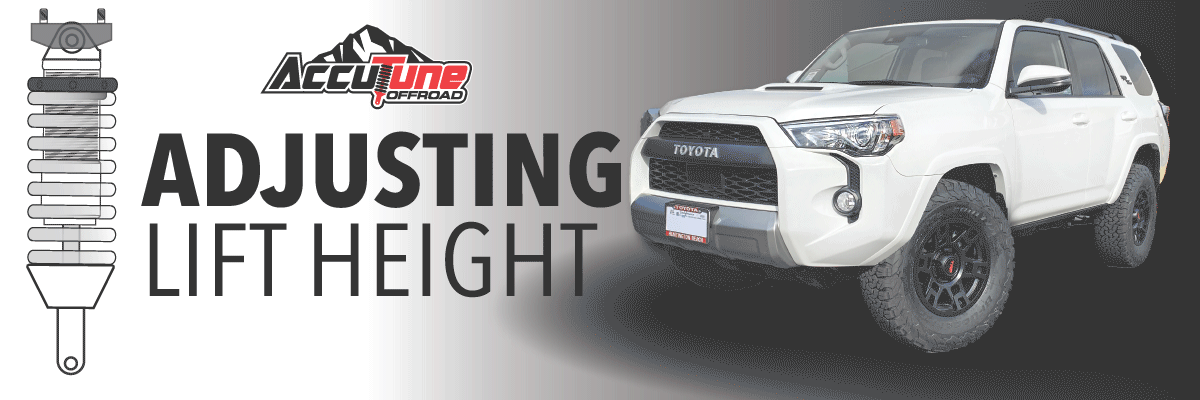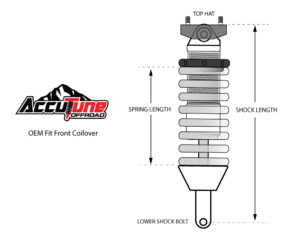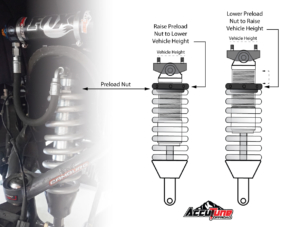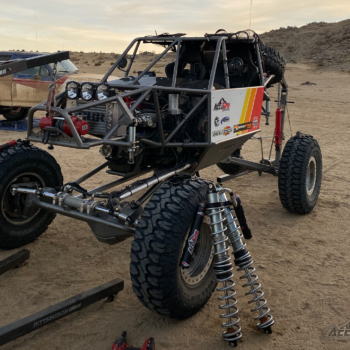Adjusting Preload on OEM Fit Front Coilovers
July 13, 2021
This article is going to explain how to adjust preload on adjustable aftermarket front coilovers for most trucks and SUVs. Why? Adjusting preload on your front coilovers will raise or lower the lift height (aka ride height). This may be for looks or performance.
Please note: Making adjustments to your coilovers should be done by an experienced mechanic. AccuTune Offroad is not responsible for any damages to you or your shocks. For the purpose of this article, we are going to reference Fox and King coilovers only. This article is not vehicle specific and covers a wide variety of vehicles with adjustable coilovers.
Before: If you have not installed your coilovers yet, now is a good time to measure your stock ride height. You can compare this later on to see what your actual lift height is. Measuring current ride height can be done a few different ways, so choose the method that works best for you. Examples of measurement locations would be: surface of the ground to center of differential skid plate or center of your wheel to the fender.
Once your coilovers are installed on the vehicle and you have driven the vehicle a short distance to get the suspension to settle, go ahead and park on a flat level surface. Next, take measurements of the shock length and spring length on each side. It is normal for driver and passenger side to be different lengths.
DRIVER SIDE Spring Length:____ Shock Length:_____
PASSENGER SIDE Spring Length:____ Shock Length:_____
 Once you have measurements for both front coilovers, you will need to find out where the shocks are sitting at ride height compared their total lengths fully extended. If there is too much lift and the shock is nearly topped out (completely extended) at ride height, it will ride very poorly. The same can be said for the opposite, however thats not usually an issue.
Once you have measurements for both front coilovers, you will need to find out where the shocks are sitting at ride height compared their total lengths fully extended. If there is too much lift and the shock is nearly topped out (completely extended) at ride height, it will ride very poorly. The same can be said for the opposite, however thats not usually an issue.
AccuTune Offroad maximum recommended shock length at ride height:
Based on our experience, we recommend at least 3” of droop at the wheel from ride height. With that in mind, we have calculated a few vehicles max shock length at ride height (see chart below). This information is based on the shocks compressed and extended length and the motion ratio of the suspension setup.
If your shocks are on that chart, and you would like to make changes, continue on below. If your shocks are not on there, we may not have the information required to get you our exact recommended shock lengths at ride height.
Max Shock Length Chart
Shock data as of 7/21/22. Manufactures may update lengths without notice, please verify your lengths before proceeding. Please refer to this diagram to confirm how our measurements are being taken.
| Vehicle | Description | Part Number | Compressed Length | Extended Length |
Recommended Max Shock Length at Ride Height
|
| 05+ Tacoma | Fox 2.0 IFP Coilover 0-2″ | FOX-985-02-002 | 17.6 | 22.225 | 20.625 |
| Fox 2.5 IFP Coilover 0-2″ | FOX-880-02-361 | 17.58 | 22.19 | 20.5 | |
| Fox 2.5 IFP Coilover 0-3″ | FOX-883-02-025 | 17.58 | 22.52 | 21 | |
| Fox 2.5 Coilover 0-2″ | FOX-880-02-376 | 17.59 | 22.13 | 20.5 | |
| Fox 2.5 Coilover 0-3″ | FOX-880-02-418 | 17.59 | 22.55 | 21 | |
| Fox 2.5 PES Coilover 0-3″ | FOX-883-06-178 | 17.19 | 22.42 | 21 | |
| Fox 2.5 Coilover 4-6″ | FOX-883-02-048 | 20.45 | 26.25 | 24.625 | |
| King 2.5 Coilovers 0-2″ | KRS-25001-119 | 17.308 | 22.375 | 20.75 | |
| King 2.5 Coilovers 0-3″ | KRS-25001-119-EXT | 17.3 | 22.6 | 21 | |
| 03+ 4Runner | Fox 2.5 IFP Coilover 0-2″ | FOX-883-02-130 | 17.58 | 22.19 | 20.5 |
| Fox 2.5 IFP Coilover 0-3″ | FOX-883-02-025 | 17.585 | 22.52 | 21 | |
| Fox 2.5 R/R Coilover 0-2″ | FOX-883-02-111 | 17.09 | 21.88 | 20.25 | |
| Fox 2.5 R/R Coilover 0-3″ | FOX-883-02-130 | 17.09 | 22.38 | 20.875 | |
| King 2.5 Coilovers | KRS-25001-278 | 17.246 | 22.313 | 20.75 | |
| King 2.5 Coilovers -EXT |
KRS-25001-278-EXT
|
N/A | N/A | N/A | |
| King 2.5 Coilovers (KDSS) | KRS-25001-243 | 17.308 | 22.625 | 21 | |
|
King 2.5 Coilovers – EXT (KDSS)
|
KRS-25001-243-EXT
|
N/A | N/A | N/A | |
| 07+ Tundra | Fox 2.0 IFP Coilover 0-2″ | FOX-985-02-004 | 19.4 | 25.325 | 23.25 |
| Fox 2.5 IFP Coilover 0-2″ | FOX-883-02-021 | 19.36 | 25.37 | 23.375 | |
| Fox 2.5 R/R Coilover 0-2″ | FOX-880-02-367 | 18.86 | 25.33 | 23.25 | |
| Fox 2.5 R/R Coilover 0-3″ | FOX-880-02-947 | 18.86 | 25.53 | 23.5 | |
| King 2.5 R/R | KRS-25001-143 | 18.147 | 25.083 | 23.043 | |
| King 2.5 R/R |
KRS-25001-143-EXT
|
18 | 25.7 | 23.66 | |
| 14+ F150 | Fox 0-2″ 2.0 IFP | FOX-985-02-015 | 18.28 | 23.21 | 21.25 |
| Fox 2.5 R/R 0-2″ | FOX-883-06-132 | 17.95 | 23.49 | 21.625 | |
| King 2.5 R/R | KRS-25001-331 | 17.9801 | 23.325 | 21.525 | |
| 21+ Bronco | Fox 2.5 PES Front Coilover | FOX-883-06-212 or -209 | 18.79 | 24.26 | 22.50 |
| Fox 2.5 PES Rear Coilover | FOX-883-06-213 or -210 | 19.24 | 27.21 | 23.00 | |
| King 2.5 Front Coilover | KRS-25001-392A | 18.50 | 24.60 | 22.50 | |
| King 2.5 Front Coilover – with AOR Upgrade | KRS-25001-392A | 18.50 | 24.30 | 22.50 | |
| King 2.5 Rear Coilover | KRS-25001-393A | 18.50 | 27.00 | 23.00 | |
| 07-18 Chevy/ GMC 1500 | Fox 2.5 IFP Coilover | FOX-883-02-028 | 15.015 | 20.365 | 18.69 |
| Fox 2.5 Coilover 0-2″ | FOX-883-02-121 | 14.9 | 19.34 | 17.66 | |
| Fox 2.5 Coilover 0-3″ | FOX-880-02-525 | 14.98 | 20.34 | 18.66 | |
| Fox 2.5 Coilover 4-6″ | FOX-883-06-079 | 15.28 | 21.41 | 21.5 |
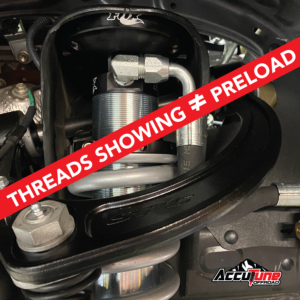 Preload
Preload
Preload does not equal the amount of threads showing on the coilover. Preload is the initial (pre) tension (load) on your springs before carrying the weight of the vehicle. Coilover spring preload is measured in inches, in other words, how many inches have you compressed the springs before applying weight. Example: A 14″ long spring that measures 12″ tall when installed on the coilover has 2″ of preload (measured when shock fully extended).
If you choose to adjust preload on the coilovers, we recommend using a professional grade spring compressor that is designed to compress heavy rate springs. Keep in mind these springs take a tremendous amount of force to compress. For example a 14” x 700lb spring requires 700lbs of force to compress 1 inch. That same spring requires 1,400lb of force to compress the spring 2” (that’s a lot of force). A spring compressor will compress the spring enough to allow the preload nut to rotate by hand. Make adjustments accordingly.
 NOT recommended: If you want to adjust preload on your own, make sure the vehicle is off the ground and the shocks are fully extended. You want as much weight off those springs as possible. Loosen the preload nut screw enough to allow the preload collar to rotate, do not remove. Using a spanner wrench or other tool, rotate preload nut as needed. Most OEM fit King coilovers come with a punch to adjust preload, Fox does not include any type of adjustment tool with the shocks. We do not recommend this method because it requires a lot of physical effort to rotate the spring and you will most likely scratch up the shock and possibly round out the spanner wrench holes in the preload nut (see photo). You also run the risk of skipping threads on the preload nut which could cause the preload nut to get bound up or damage the threads on the shock body. Replacing the preload nut on a coilover is not simple and will require most of the shock to be taken apart. This equals an expensive repair.
NOT recommended: If you want to adjust preload on your own, make sure the vehicle is off the ground and the shocks are fully extended. You want as much weight off those springs as possible. Loosen the preload nut screw enough to allow the preload collar to rotate, do not remove. Using a spanner wrench or other tool, rotate preload nut as needed. Most OEM fit King coilovers come with a punch to adjust preload, Fox does not include any type of adjustment tool with the shocks. We do not recommend this method because it requires a lot of physical effort to rotate the spring and you will most likely scratch up the shock and possibly round out the spanner wrench holes in the preload nut (see photo). You also run the risk of skipping threads on the preload nut which could cause the preload nut to get bound up or damage the threads on the shock body. Replacing the preload nut on a coilover is not simple and will require most of the shock to be taken apart. This equals an expensive repair.
Small preload changes, make big lift height changes. The amount of preload you add on an IFS truck does not equal the amount of lift you will achieve. 1” of preload does not equal 1” of lift height on an IFS front suspension. Threads showing also does not equal preload. Since the shock is mounted on a control arm with a motion ratio, the amount of preload needed to gain X height will vary. Ballpark reference would be ½” preload equals 1” at the wheel.
Make preload adjustments as needed. Reminder, there may be more threads showing on one coilover compared to the other side. This is normal to compensate for any uneven weight on the vehicle like gas tank, car battery or any other modifications. Once the shocks are back on the truck, make sure everything torqued properly.
Check Ride Height
Once everything is torqued, take the vehicle for a short drive to settle the suspension down to its normal ride height. Make sure vehicle is on a flat and level surface, preferably the original location you measured from earlier. Measure shock lengths again to see how much taller or lower the vehicle is from previous length. Continue making adjustments as necessary.
Pro Tip: At ride height, measure the shock lengths on your vehicle. Raise or lower vehicle (by adding weight or jacking up the vehicle) to get your desired ride height. Measure shock lengths again and adjust preload with the difference in length.
TROUBLESHOOTING
Too much thread showing?
 Depending on the spring size, there may be a lot of threads showing on the coilover above the preload nut. Don’t let this discourage you, or make you think your springs are wrong. It’s common for different manufacturers to use different length springs, which can show more or less threads on a properly setup coilover shock.
Depending on the spring size, there may be a lot of threads showing on the coilover above the preload nut. Don’t let this discourage you, or make you think your springs are wrong. It’s common for different manufacturers to use different length springs, which can show more or less threads on a properly setup coilover shock. Too much preload?
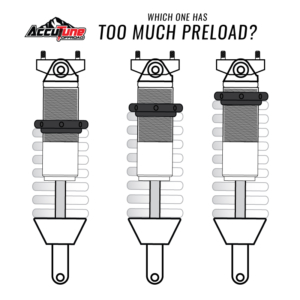 Although sometimes it’s ok to have a lot of threads showing on the coilover, this can also be a sign the coilover has too much preload. This is just a sign, and is not a clear indicator the coilover has too much preload. See graphic to the left, which coilover has too much preload? By simply looking at these graphics there is no way to give an accurate answer, it would just be a guess. Without knowing the shock travel, spring travel and spring length we would not know for sure if there is too much preload or not.
Although sometimes it’s ok to have a lot of threads showing on the coilover, this can also be a sign the coilover has too much preload. This is just a sign, and is not a clear indicator the coilover has too much preload. See graphic to the left, which coilover has too much preload? By simply looking at these graphics there is no way to give an accurate answer, it would just be a guess. Without knowing the shock travel, spring travel and spring length we would not know for sure if there is too much preload or not.
“Too much thread showing” is usually a personal preference. To reduce the amount of threads showing on a coilover, the spring can be replaced with a different rate or length. You should confirm the new spring rate will fit and is the proper weight rating for your vehicle before making the change.
What is Coil Bind?
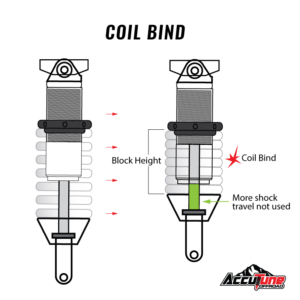 Too much preload or incorrect spring rate can cause a spring to compress too much and go into “coil bind”. Coil bind is when your spring is compressed to the max and reaches block height. This will ultimately stop the coilover from compressing entirely which would limit shock travel and damage the shock and spring.
Too much preload or incorrect spring rate can cause a spring to compress too much and go into “coil bind”. Coil bind is when your spring is compressed to the max and reaches block height. This will ultimately stop the coilover from compressing entirely which would limit shock travel and damage the shock and spring.
How do you measure preload?
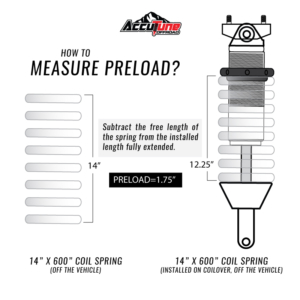 To measure preload on your coilover, you will need to know the spring free length. Most springs have the length and weight rating on them, if not you can check our site or search online for the part number on the spring. With the coilover shock completely extended, measure the spring length. Subtract this number from the springs actual length. Example: You have a 14” x 700lb spring on a Tacoma coilover that is 12.25” long when fully extended, this means the coilover has 1.75” of preload.
To measure preload on your coilover, you will need to know the spring free length. Most springs have the length and weight rating on them, if not you can check our site or search online for the part number on the spring. With the coilover shock completely extended, measure the spring length. Subtract this number from the springs actual length. Example: You have a 14” x 700lb spring on a Tacoma coilover that is 12.25” long when fully extended, this means the coilover has 1.75” of preload.What is the maximum amount of preload you can have?
This will depend on total shock travel and spring travel you have on the coilover. Keep in mind preload numbers may be different side to side on the front of the vehicle.
Min Preload = (spring free length) – (coilover spring space)
*If you choose too heavy of a spring rate you may have min preload issues, causing the vehicle to be lifted too high.
Maximum preload= (spring travel) – (shock travel)
See below for a list of Eibach Spring rate info. Most product pages will list shock travel in the specifications tab.
Spring date from Eibach as of 7/6/21
| Eibach Spring Data | |||||
|---|---|---|---|---|---|
| Part Number | ID | Free Length | Rate | Block Height | Travel |
| ERS-1400.300.0400S | 3 | 14 | 400 | 5.59 | 8.41 |
| ERS-1400.300.0450S | 3 | 14 | 450 | 5.83 | 8.17 |
| ERS-1400.300.0500S | 3 | 14 | 500 | 6.02 | 7.98 |
| ERS-1400.300.0550S | 3 | 14 | 550 | 6.38 | 7.62 |
| ERS-1400.300.0600S | 3 | 14 | 600 | 6.26 | 7.74 |
| ERS-1400.300.0650S | 3 | 14 | 650 | 6.61 | 7.39 |
| ERS-1400.300.0700s | 3 | 14 | 700 | 6.57 | 7.43 |
| ERS-1600.300.0350S | 3 | 16 | 350 | 6.46 | 9.54 |
| ERS-1600.300.0400S | 3 | 16 | 400 | 6.61 | 9.39 |
| ERS-1600.300.0450S | 3 | 16 | 450 | 6.81 | 9.19 |
| ERS-1600.300.0500S | 3 | 16 | 500 | 7.52 | 8.48 |
| ERS-1600.300.0550S | 3 | 16 | 550 | 7.6 | 8.4 |
| ERS-1600.300.0600S | 3 | 16 | 600 | 7.72 | 8.28 |
| ERS-1600.300.0700S | 3 | 16 | 700 | 8.03 | 7.97 |
| ERS-1600.300.0800S | 3 | 16 | 800 | 8.15 | 7.85 |
| ERS-1800.300.0400S | 3 | 18 | 400 | 7.76 | 10.24 |
| ERS-1800.300.0450S | 3 | 18 | 450 | 8.19 | 9.81 |
| ERS-1800.300.0500S | 3 | 18 | 500 | 8.43 | 9.57 |
| ERS-1800.300.0550S | 3 | 18 | 550 | 8.5 | 9.5 |
| ERS-1800.300.0600S | 3 | 18 | 600 | 8.86 | 9.14 |
| ERS-1800.300.0650S | 3 | 18 | 650 | 8.98 | 9.02 |
| ERS-1800.300.0700S | 3 | 18 | 700 | 9.09 | 8.91 |
| ERS-1800.300.0800S | 3 | 18 | 800 | 9.76 | 8.24 |
Do I need a heavier spring rate?
If you have done everything above and your coilovers are close to the max preload setting, you may need a heavier rate spring. Feel free to give us a call and we can run through your setup and help get you a recommended spring rate.
Do I need a softer spring rate?
There is a combination of things we take into consideration when looking at a truck that might be over-sprung, or has too heavy of a spring rate. The two main things we would look at is the shock length compared to our max recommended length and compare that to the amount of threads on the shock body. If the shock length is too tall (at ride height), and there is no room to back off the preload, you need a new spring rate. There is not usually a minimum amount of preload required on these OEM fit coilovers, since most of the time they require preload just to get the spring on the coilover.
What if your truck is leaning to one side?
It’s common and normal for a truck to have a slight lean. Typically this is due to more weight being on one side of the truck and not having a completely balanced vehicle on each corner. No big deal, just add or reduce preload on the coilovers to compensate for the lean. Do not add spacers to the top of the coilovers.

